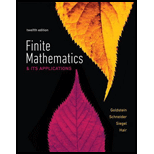
Concept explainers
An urn contains four red balls and six white balls. Suppose that two balls are drawn at random from the urn, and let X be the number of red balls drawn. The probability of obtaining two red balls depends on whether the balls are drawn with or without replacement. The purpose of this project is to show that the expected number of red balls drawn is not affected by whether or not the first ball is replaced before the second ball is drawn. The idea for this project was taken from the article “An Unexpected Expected Value,” by Stephen Schwartzman, which appeared in the February 1993 issue of The Mathematics Teacher.
Pretend that the 10 balls are ping-pong balls, that they have been finely ground up, and that the red and white specks have been thoroughly mixed. Forty percent of the specks will be red, and 60% will be white. Suppose that you stir the specks and use a tablespoon to scoop out 10% of the specks. That is, suppose that the tablespoon holds a quantity of specks corresponding to one ball.
(a) What percentage of a red ball is contained in the spoon?
(b) What percentage of the remaining specks in the urn are red?
(c) If the spoonful of specks is replaced, does the percentage of red specks in the urn change?
(d) Use the results from parts (b) and (c) to explain why the expected number of red balls as calculated in parts 6 and 7 is the same with and without replacement.
Want to see the full answer?
Check out a sample textbook solution
Chapter 7 Solutions
Pearson eText for Finite Mathematics & Its Applications -- Instant Access (Pearson+)
Additional Math Textbook Solutions
Pathways To Math Literacy (looseleaf)
Precalculus
College Algebra Essentials (5th Edition)
College Algebra (Collegiate Math)
Elementary and Intermediate Algebra: Concepts and Applications (7th Edition)
Intermediate Algebra (13th Edition)
- 4. Solve the system of equations and express your solution using vectors. 2x1 +5x2+x3 + 3x4 = 9 -x2+x3 + x4 = 1 -x1-6x2+3x3 + 2x4 = -1arrow_forward3. Simplify the matrix expression A(A-B) - (A+B)B-2(A - B)2 + (A + B) 2arrow_forward[2 pts] 1. Let A = [. 1 -1 0 -343 and B = 05 5 -7 304 Compute (7A - 3B) - 4(2A - B).arrow_forward
- 20 2. Let A = = [ -2 0 1 3 ] and B = 2 3 -1 2 For each of the following, calculate the product or indicate why it is undefined: (a) AB (b) BAarrow_forwardTrue or False and whyarrow_forward10 5 Obtain by multiplying matrices the composite coordinate transformation of two transformations, first x' = (x + y√√2+2)/2 y' = z' (x√√2-2√2)/2 z = (-x+y√√2-2)/2 followed by x" = (x'√√2+z'√√2)/2 y" = (-x'y'√√2+2')/2 z" = (x'y'√√2-2')/2.arrow_forward
- Not use ai pleasearrow_forward4 The plane 2x+3y+ 6z = 6 intersects the coordinate axes at P, Q, and R, forming a triangle. Draw a figure and identify the three points on it. Also find vectors PQ and PR. Write a vector formula for the area of the triangle PQR and find its value.arrow_forward3.1 Limits 1. If lim f(x)=-6 and lim f(x)=5, then lim f(x). Explain your choice. x+3° x+3* x+3 (a) Is 5 (c) Does not exist (b) is 6 (d) is infinitearrow_forward
- 1 pts Let F and G be vector fields such that ▼ × F(0, 0, 0) = (0.76, -9.78, 3.29), G(0, 0, 0) = (−3.99, 6.15, 2.94), and G is irrotational. Then sin(5V (F × G)) at (0, 0, 0) is Question 1 -0.246 0.072 -0.934 0.478 -0.914 -0.855 0.710 0.262 .arrow_forwardAnswer the number questions with the following answers +/- 2 sqrt(2) +/- i sqrt(6) (-3 +/-3 i sqrt(3))/4 +/-1 +/- sqrt(6) +/- 2/3 sqrt(3) 4 -3 +/- 3 i sqrt(3)arrow_forward2. Answer the following questions. (A) [50%] Given the vector field F(x, y, z) = (x²y, e", yz²), verify the differential identity Vx (VF) V(V •F) - V²F (B) [50%] Remark. You are confined to use the differential identities. Let u and v be scalar fields, and F be a vector field given by F = (Vu) x (Vv) (i) Show that F is solenoidal (or incompressible). (ii) Show that G = (uvv – vVu) is a vector potential for F.arrow_forward
- Algebra & Trigonometry with Analytic GeometryAlgebraISBN:9781133382119Author:SwokowskiPublisher:Cengage

 College Algebra (MindTap Course List)AlgebraISBN:9781305652231Author:R. David Gustafson, Jeff HughesPublisher:Cengage Learning
College Algebra (MindTap Course List)AlgebraISBN:9781305652231Author:R. David Gustafson, Jeff HughesPublisher:Cengage Learning  College AlgebraAlgebraISBN:9781305115545Author:James Stewart, Lothar Redlin, Saleem WatsonPublisher:Cengage Learning
College AlgebraAlgebraISBN:9781305115545Author:James Stewart, Lothar Redlin, Saleem WatsonPublisher:Cengage Learning Holt Mcdougal Larson Pre-algebra: Student Edition...AlgebraISBN:9780547587776Author:HOLT MCDOUGALPublisher:HOLT MCDOUGAL
Holt Mcdougal Larson Pre-algebra: Student Edition...AlgebraISBN:9780547587776Author:HOLT MCDOUGALPublisher:HOLT MCDOUGAL




